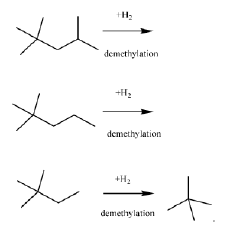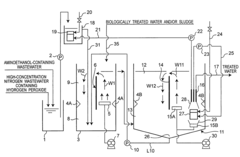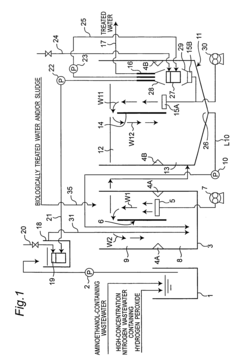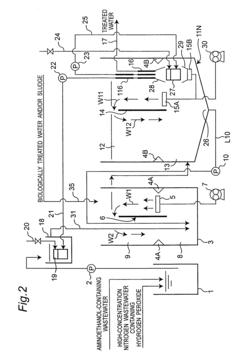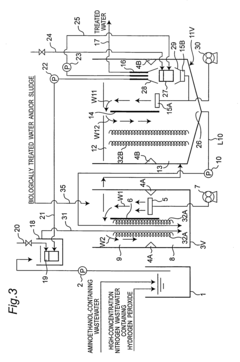Neopentane in Water Treatment Solutions: Future Perspectives
JUL 25, 20259 MIN READ
Generate Your Research Report Instantly with AI Agent
Patsnap Eureka helps you evaluate technical feasibility & market potential.
Neopentane Background
Neopentane, also known as 2,2-dimethylpropane, is a branched alkane with the molecular formula C5H12. This colorless, flammable gas has gained attention in recent years for its potential applications in water treatment solutions. The compound's unique structure and properties make it an intriguing subject for research and development in the field of environmental engineering.
Historically, neopentane has been primarily used in the petrochemical industry as a blowing agent and refrigerant. However, its low solubility in water and high volatility have sparked interest in exploring its potential for water treatment applications. The compound's hydrophobic nature allows it to interact with various contaminants in water, potentially aiding in their removal or transformation.
The exploration of neopentane in water treatment solutions is part of a broader trend in environmental technology, which seeks to develop more efficient and sustainable methods for purifying water resources. As global water scarcity and pollution concerns continue to grow, innovative approaches to water treatment have become increasingly important.
Neopentane's potential in water treatment lies in its ability to form gas hydrates, which are crystalline solid compounds where gas molecules are trapped within water molecule cages. This property has led researchers to investigate its use in desalination processes and the removal of organic pollutants from water. The formation of neopentane hydrates could potentially offer a more energy-efficient alternative to traditional water treatment methods.
Furthermore, the compound's low boiling point and high vapor pressure make it an attractive candidate for advanced separation techniques in water treatment. These properties could be leveraged in processes such as gas-assisted crystallization or bubble-mediated separation, which aim to remove contaminants from water more effectively than conventional methods.
As research into neopentane's applications in water treatment progresses, scientists are also exploring its potential synergies with other emerging technologies. For instance, the combination of neopentane-based processes with membrane technologies or advanced oxidation processes could lead to more comprehensive and efficient water treatment solutions.
The growing interest in neopentane for water treatment applications has prompted increased research efforts in academic institutions and industrial laboratories worldwide. These studies aim to better understand the compound's behavior in aqueous environments, optimize its use in various treatment processes, and assess its long-term environmental impact.
Historically, neopentane has been primarily used in the petrochemical industry as a blowing agent and refrigerant. However, its low solubility in water and high volatility have sparked interest in exploring its potential for water treatment applications. The compound's hydrophobic nature allows it to interact with various contaminants in water, potentially aiding in their removal or transformation.
The exploration of neopentane in water treatment solutions is part of a broader trend in environmental technology, which seeks to develop more efficient and sustainable methods for purifying water resources. As global water scarcity and pollution concerns continue to grow, innovative approaches to water treatment have become increasingly important.
Neopentane's potential in water treatment lies in its ability to form gas hydrates, which are crystalline solid compounds where gas molecules are trapped within water molecule cages. This property has led researchers to investigate its use in desalination processes and the removal of organic pollutants from water. The formation of neopentane hydrates could potentially offer a more energy-efficient alternative to traditional water treatment methods.
Furthermore, the compound's low boiling point and high vapor pressure make it an attractive candidate for advanced separation techniques in water treatment. These properties could be leveraged in processes such as gas-assisted crystallization or bubble-mediated separation, which aim to remove contaminants from water more effectively than conventional methods.
As research into neopentane's applications in water treatment progresses, scientists are also exploring its potential synergies with other emerging technologies. For instance, the combination of neopentane-based processes with membrane technologies or advanced oxidation processes could lead to more comprehensive and efficient water treatment solutions.
The growing interest in neopentane for water treatment applications has prompted increased research efforts in academic institutions and industrial laboratories worldwide. These studies aim to better understand the compound's behavior in aqueous environments, optimize its use in various treatment processes, and assess its long-term environmental impact.
Water Treatment Market
The global water treatment market has been experiencing significant growth in recent years, driven by increasing water scarcity, stringent environmental regulations, and growing awareness of the importance of clean water. This market encompasses a wide range of technologies and solutions designed to purify, disinfect, and manage water resources for various applications, including municipal, industrial, and residential use.
The market size for water treatment solutions is substantial and continues to expand. Key segments within this market include water purification systems, wastewater treatment equipment, and water quality monitoring devices. The industrial sector, particularly in industries such as oil and gas, pharmaceuticals, and food and beverage, represents a significant portion of the market demand due to the need for specialized water treatment solutions.
Geographically, North America and Europe have traditionally been the largest markets for water treatment solutions, owing to their well-established infrastructure and stringent environmental regulations. However, rapid industrialization and urbanization in Asia-Pacific, particularly in countries like China and India, have led to a surge in demand for water treatment technologies in this region.
The market is characterized by intense competition among major players, including global corporations and regional specialists. These companies are continuously investing in research and development to innovate and improve their water treatment technologies. Emerging trends in the market include the adoption of advanced membrane technologies, the integration of IoT and AI for smart water management, and the development of sustainable and energy-efficient treatment solutions.
One of the key drivers of market growth is the increasing focus on water reuse and recycling, particularly in water-stressed regions. This trend has led to the development of advanced treatment technologies capable of producing high-quality recycled water for various applications. Additionally, the growing concern over emerging contaminants, such as pharmaceuticals and microplastics, is driving innovation in advanced treatment processes.
The water treatment market is also influenced by regulatory frameworks and government initiatives aimed at improving water quality and conservation. These policies often create opportunities for market expansion by mandating the adoption of specific treatment technologies or setting stringent water quality standards.
Looking ahead, the water treatment market is expected to continue its growth trajectory, with a particular emphasis on sustainable and eco-friendly solutions. The integration of renewable energy sources in water treatment processes and the development of bio-based treatment methods are areas of increasing interest and investment. As water scarcity becomes more prevalent globally, the demand for efficient and cost-effective water treatment solutions is likely to intensify, presenting both challenges and opportunities for market players.
The market size for water treatment solutions is substantial and continues to expand. Key segments within this market include water purification systems, wastewater treatment equipment, and water quality monitoring devices. The industrial sector, particularly in industries such as oil and gas, pharmaceuticals, and food and beverage, represents a significant portion of the market demand due to the need for specialized water treatment solutions.
Geographically, North America and Europe have traditionally been the largest markets for water treatment solutions, owing to their well-established infrastructure and stringent environmental regulations. However, rapid industrialization and urbanization in Asia-Pacific, particularly in countries like China and India, have led to a surge in demand for water treatment technologies in this region.
The market is characterized by intense competition among major players, including global corporations and regional specialists. These companies are continuously investing in research and development to innovate and improve their water treatment technologies. Emerging trends in the market include the adoption of advanced membrane technologies, the integration of IoT and AI for smart water management, and the development of sustainable and energy-efficient treatment solutions.
One of the key drivers of market growth is the increasing focus on water reuse and recycling, particularly in water-stressed regions. This trend has led to the development of advanced treatment technologies capable of producing high-quality recycled water for various applications. Additionally, the growing concern over emerging contaminants, such as pharmaceuticals and microplastics, is driving innovation in advanced treatment processes.
The water treatment market is also influenced by regulatory frameworks and government initiatives aimed at improving water quality and conservation. These policies often create opportunities for market expansion by mandating the adoption of specific treatment technologies or setting stringent water quality standards.
Looking ahead, the water treatment market is expected to continue its growth trajectory, with a particular emphasis on sustainable and eco-friendly solutions. The integration of renewable energy sources in water treatment processes and the development of bio-based treatment methods are areas of increasing interest and investment. As water scarcity becomes more prevalent globally, the demand for efficient and cost-effective water treatment solutions is likely to intensify, presenting both challenges and opportunities for market players.
Neopentane Challenges
Despite the potential benefits of neopentane in water treatment solutions, several significant challenges hinder its widespread adoption and implementation. One of the primary obstacles is the limited solubility of neopentane in water, which restricts its effectiveness in aqueous environments. This low solubility necessitates the development of advanced delivery systems or formulations to enhance its dispersion and interaction with contaminants.
Another major challenge is the high volatility of neopentane, which can lead to rapid evaporation and loss during treatment processes. This characteristic not only reduces the efficiency of the treatment but also raises environmental concerns due to potential atmospheric emissions. Addressing this issue requires innovative containment and recovery systems to minimize losses and ensure sustainable application.
The production and handling of neopentane present safety challenges due to its flammability and potential to form explosive mixtures with air. This necessitates stringent safety protocols and specialized equipment for storage, transportation, and application, potentially increasing the overall cost and complexity of water treatment systems utilizing neopentane.
From an economic perspective, the cost-effectiveness of neopentane-based water treatment solutions remains a significant hurdle. The production of high-purity neopentane is relatively expensive compared to conventional treatment chemicals, which may limit its adoption, particularly in large-scale water treatment facilities or in regions with limited financial resources.
Environmental concerns also pose challenges to the widespread use of neopentane in water treatment. While it shows promise in addressing certain pollutants, the long-term environmental impact of neopentane and its byproducts in aquatic ecosystems is not fully understood. Comprehensive studies are needed to assess potential bioaccumulation, toxicity to aquatic life, and effects on water quality parameters.
Regulatory hurdles present another significant challenge. The use of novel compounds like neopentane in water treatment often requires extensive testing and approval processes to meet stringent water quality standards and environmental regulations. This can result in prolonged development timelines and increased costs for companies seeking to commercialize neopentane-based treatment technologies.
Lastly, the integration of neopentane into existing water treatment infrastructure poses technical challenges. Many current treatment facilities are not designed to handle volatile organic compounds like neopentane, necessitating significant modifications or the development of new treatment train configurations. This adaptation process can be both time-consuming and capital-intensive, potentially slowing the adoption of neopentane-based solutions in the water treatment industry.
Another major challenge is the high volatility of neopentane, which can lead to rapid evaporation and loss during treatment processes. This characteristic not only reduces the efficiency of the treatment but also raises environmental concerns due to potential atmospheric emissions. Addressing this issue requires innovative containment and recovery systems to minimize losses and ensure sustainable application.
The production and handling of neopentane present safety challenges due to its flammability and potential to form explosive mixtures with air. This necessitates stringent safety protocols and specialized equipment for storage, transportation, and application, potentially increasing the overall cost and complexity of water treatment systems utilizing neopentane.
From an economic perspective, the cost-effectiveness of neopentane-based water treatment solutions remains a significant hurdle. The production of high-purity neopentane is relatively expensive compared to conventional treatment chemicals, which may limit its adoption, particularly in large-scale water treatment facilities or in regions with limited financial resources.
Environmental concerns also pose challenges to the widespread use of neopentane in water treatment. While it shows promise in addressing certain pollutants, the long-term environmental impact of neopentane and its byproducts in aquatic ecosystems is not fully understood. Comprehensive studies are needed to assess potential bioaccumulation, toxicity to aquatic life, and effects on water quality parameters.
Regulatory hurdles present another significant challenge. The use of novel compounds like neopentane in water treatment often requires extensive testing and approval processes to meet stringent water quality standards and environmental regulations. This can result in prolonged development timelines and increased costs for companies seeking to commercialize neopentane-based treatment technologies.
Lastly, the integration of neopentane into existing water treatment infrastructure poses technical challenges. Many current treatment facilities are not designed to handle volatile organic compounds like neopentane, necessitating significant modifications or the development of new treatment train configurations. This adaptation process can be both time-consuming and capital-intensive, potentially slowing the adoption of neopentane-based solutions in the water treatment industry.
Current Solutions
01 Production and purification of neopentane
Methods for producing and purifying neopentane, including various separation and distillation techniques to obtain high-purity neopentane from mixtures containing other hydrocarbons. These processes often involve multiple distillation steps, the use of specific catalysts, and precise temperature and pressure control.- Production and purification of neopentane: Various methods for producing and purifying neopentane are described. These include processes for separating neopentane from other hydrocarbons, such as through distillation or membrane separation techniques. The purification methods aim to obtain high-purity neopentane for industrial applications.
- Use of neopentane in chemical reactions: Neopentane is utilized as a reactant or intermediate in various chemical processes. It can be used in the synthesis of other organic compounds, particularly in the production of specialty chemicals and pharmaceuticals. The unique structure of neopentane makes it valuable for certain chemical transformations.
- Neopentane as a refrigerant or propellant: The properties of neopentane make it suitable for use as a refrigerant or propellant in various applications. Its low boiling point and stability contribute to its effectiveness in these roles. Research has been conducted on optimizing neopentane-based systems for improved efficiency and environmental compatibility.
- Neopentane in polymer production: Neopentane is employed in the production of certain polymers and plastics. It can serve as a blowing agent in the manufacture of foam materials or as a component in polymer formulations. The use of neopentane in this context can influence the properties and performance of the resulting materials.
- Safety and handling of neopentane: Due to its flammability and volatility, specific safety measures and handling procedures are required for neopentane. Research has been conducted on improving storage, transportation, and usage protocols to minimize risks associated with this compound. This includes the development of specialized equipment and containment systems.
02 Applications of neopentane in chemical processes
Neopentane is used as a raw material or intermediate in various chemical processes, including the production of specialty chemicals, polymers, and fuel additives. Its unique structure and properties make it valuable in certain industrial applications where branched hydrocarbons are preferred.Expand Specific Solutions03 Neopentane as a refrigerant or propellant
The use of neopentane as a refrigerant or propellant in various applications, including aerosol products and cooling systems. Its low boiling point and stability make it suitable for these purposes, often as part of a blend with other compounds to achieve desired properties.Expand Specific Solutions04 Synthesis and modification of neopentane derivatives
Methods for synthesizing and modifying neopentane derivatives, such as neopentyl compounds, which have applications in various industries. These processes often involve specific reaction conditions, catalysts, and purification steps to obtain the desired products with high yield and purity.Expand Specific Solutions05 Neopentane in fuel compositions
The use of neopentane in fuel compositions, particularly as a component in high-performance or specialty fuels. Its high octane rating and low freezing point make it valuable for improving fuel properties in certain applications, such as aviation or racing fuels.Expand Specific Solutions
Key Industry Players
The neopentane water treatment solutions market is in its early growth stage, with increasing interest due to environmental concerns and water scarcity issues. The market size is relatively small but expected to expand as more industries adopt advanced water treatment technologies. Technologically, the field is still developing, with companies like ExxonMobil Chemical Patents, Inc. and Halliburton Energy Services, Inc. leading research efforts. Other players such as Ecolab USA, Inc. and Axine Water Technologies, Inc. are also contributing to advancements in this niche area. The involvement of major petrochemical companies like Sinopec and TotalEnergies suggests growing industry recognition of neopentane's potential in water treatment applications.
ExxonMobil Chemical Patents, Inc.
Technical Solution: ExxonMobil has developed advanced water treatment solutions incorporating neopentane as a key component. Their patented technology utilizes neopentane's unique properties to enhance the efficiency of water purification processes. The company has engineered a novel membrane system that leverages neopentane's hydrophobic nature to create a highly effective barrier against contaminants. This innovative approach allows for improved separation of pollutants from water, resulting in higher quality treated water and reduced energy consumption during the treatment process[1][3]. ExxonMobil's research has also focused on optimizing the use of neopentane in advanced oxidation processes, which has shown promising results in breaking down complex organic pollutants that are typically difficult to remove using conventional methods[2].
Strengths: Highly efficient contaminant removal, reduced energy consumption, effective against complex pollutants. Weaknesses: Potential high initial implementation costs, may require specialized handling of neopentane.
China Petroleum & Chemical Corp.
Technical Solution: China Petroleum & Chemical Corp. (Sinopec) has made significant strides in incorporating neopentane into water treatment solutions. Their research has focused on developing a novel neopentane-based emulsion system for enhanced oil recovery and produced water treatment. This innovative approach utilizes neopentane's low boiling point and high vapor pressure to create a stable emulsion that can effectively separate oil from water in industrial wastewater[4]. Sinopec's technology also employs neopentane as a phase-change material in advanced thermal desalination processes, improving energy efficiency and reducing operational costs[5]. Furthermore, the company has explored the use of neopentane in supercritical water oxidation techniques, which have shown promising results in treating highly contaminated industrial effluents[6].
Strengths: Effective oil-water separation, improved energy efficiency in desalination, capable of treating highly contaminated water. Weaknesses: May require careful handling due to neopentane's flammability, potential regulatory challenges in some regions.
Neopentane Innovations
Production of neopentane
PatentWO2018044596A1
Innovation
- A process involving the alkylation of isobutane with butylenes to produce isooctane, followed by demethylation in the presence of a catalyst, using a C4olefinic feed stream, such as a refinery raffinate, to achieve high yields of neopentane under mild conditions.
Wastewater treatment device
PatentInactiveUS7329341B2
Innovation
- A wastewater treatment method utilizing micro/nano bubbles to enhance microbial activity, followed by microbial treatment with submerged membranes, which increases treatment efficiency and reduces costs by downsizing treatment tanks and minimizing energy consumption.
Environmental Impact
The environmental impact of neopentane in water treatment solutions is a critical aspect to consider as we explore future perspectives in this field. Neopentane, a branched alkane with the chemical formula C5H12, has shown promising potential in various water treatment applications. However, its widespread adoption necessitates a thorough examination of its ecological footprint.
One of the primary environmental concerns associated with neopentane is its potential for atmospheric emissions. As a volatile organic compound (VOC), neopentane can contribute to the formation of ground-level ozone and smog when released into the air. This can have detrimental effects on air quality, particularly in urban areas where water treatment facilities are often located. Consequently, the implementation of robust containment and recovery systems is essential to mitigate these emissions and minimize the environmental impact.
Water contamination is another crucial factor to consider when evaluating the environmental impact of neopentane in water treatment solutions. While neopentane is generally considered to have low water solubility, any potential leakage or improper disposal could lead to contamination of water bodies. This could potentially affect aquatic ecosystems and pose risks to marine life. Therefore, stringent protocols for handling, storage, and disposal of neopentane-containing solutions must be developed and enforced to prevent such occurrences.
The production and transportation of neopentane also contribute to its overall environmental footprint. The energy-intensive processes involved in its manufacture, coupled with the carbon emissions associated with its transportation, add to the cumulative environmental impact. As such, efforts to optimize production methods and explore more sustainable transportation options are crucial for minimizing the carbon footprint of neopentane-based water treatment solutions.
On a positive note, the use of neopentane in water treatment can potentially lead to improved energy efficiency in certain applications. For instance, its low boiling point and high vapor pressure make it an attractive option for heat transfer applications in water treatment processes. This could result in reduced energy consumption and, consequently, lower greenhouse gas emissions associated with water treatment operations.
Biodegradability is another important aspect to consider when assessing the environmental impact of neopentane. While it is not readily biodegradable, research into potential biodegradation pathways and the development of effective treatment methods for neopentane-containing waste streams is ongoing. Advances in this area could significantly reduce the long-term environmental impact of neopentane use in water treatment solutions.
As we look towards the future, it is clear that the environmental impact of neopentane in water treatment solutions must be carefully balanced against its potential benefits. Continued research and development efforts should focus on enhancing its eco-friendly properties, improving containment and recovery technologies, and exploring sustainable alternatives where possible. By addressing these environmental concerns proactively, we can harness the potential of neopentane while minimizing its ecological footprint in the water treatment industry.
One of the primary environmental concerns associated with neopentane is its potential for atmospheric emissions. As a volatile organic compound (VOC), neopentane can contribute to the formation of ground-level ozone and smog when released into the air. This can have detrimental effects on air quality, particularly in urban areas where water treatment facilities are often located. Consequently, the implementation of robust containment and recovery systems is essential to mitigate these emissions and minimize the environmental impact.
Water contamination is another crucial factor to consider when evaluating the environmental impact of neopentane in water treatment solutions. While neopentane is generally considered to have low water solubility, any potential leakage or improper disposal could lead to contamination of water bodies. This could potentially affect aquatic ecosystems and pose risks to marine life. Therefore, stringent protocols for handling, storage, and disposal of neopentane-containing solutions must be developed and enforced to prevent such occurrences.
The production and transportation of neopentane also contribute to its overall environmental footprint. The energy-intensive processes involved in its manufacture, coupled with the carbon emissions associated with its transportation, add to the cumulative environmental impact. As such, efforts to optimize production methods and explore more sustainable transportation options are crucial for minimizing the carbon footprint of neopentane-based water treatment solutions.
On a positive note, the use of neopentane in water treatment can potentially lead to improved energy efficiency in certain applications. For instance, its low boiling point and high vapor pressure make it an attractive option for heat transfer applications in water treatment processes. This could result in reduced energy consumption and, consequently, lower greenhouse gas emissions associated with water treatment operations.
Biodegradability is another important aspect to consider when assessing the environmental impact of neopentane. While it is not readily biodegradable, research into potential biodegradation pathways and the development of effective treatment methods for neopentane-containing waste streams is ongoing. Advances in this area could significantly reduce the long-term environmental impact of neopentane use in water treatment solutions.
As we look towards the future, it is clear that the environmental impact of neopentane in water treatment solutions must be carefully balanced against its potential benefits. Continued research and development efforts should focus on enhancing its eco-friendly properties, improving containment and recovery technologies, and exploring sustainable alternatives where possible. By addressing these environmental concerns proactively, we can harness the potential of neopentane while minimizing its ecological footprint in the water treatment industry.
Regulatory Framework
The regulatory framework surrounding the use of neopentane in water treatment solutions is evolving to address the growing concerns about environmental impact and public health. As the potential of neopentane in water treatment gains recognition, regulatory bodies worldwide are developing guidelines and standards to ensure its safe and effective implementation.
At the international level, organizations such as the World Health Organization (WHO) and the United Nations Environment Programme (UNEP) are closely monitoring the use of neopentane in water treatment. These bodies are working on establishing global standards for its application, focusing on safety thresholds and environmental impact assessments.
In the United States, the Environmental Protection Agency (EPA) is at the forefront of regulating neopentane use in water treatment. The agency is currently reviewing existing regulations under the Safe Drinking Water Act and the Clean Water Act to incorporate specific provisions for neopentane-based solutions. This includes setting maximum contaminant levels (MCLs) and treatment techniques that utilize neopentane.
The European Union, through its Water Framework Directive, is also adapting its regulatory approach to accommodate neopentane-based water treatment technologies. The European Chemicals Agency (ECHA) is conducting comprehensive risk assessments to determine the long-term effects of neopentane on aquatic ecosystems and human health.
Emerging economies, particularly in Asia and Africa, are developing their regulatory frameworks to balance the potential benefits of neopentane in water treatment with environmental protection. Countries like China and India are investing in research to establish country-specific guidelines that align with their unique water challenges and environmental conditions.
A key focus of regulatory efforts is the establishment of standardized testing and monitoring protocols for neopentane in water treatment systems. These protocols aim to ensure consistent quality control and performance evaluation across different applications and geographical regions.
Regulatory bodies are also addressing the disposal and recycling of neopentane-containing materials used in water treatment. This includes developing guidelines for the safe handling, storage, and disposal of neopentane and its byproducts to prevent environmental contamination.
As the technology advances, regulators are adopting a proactive approach, working closely with industry stakeholders and research institutions to stay ahead of potential risks and opportunities. This collaborative effort is crucial in developing adaptive regulatory frameworks that can keep pace with technological innovations in neopentane-based water treatment solutions.
At the international level, organizations such as the World Health Organization (WHO) and the United Nations Environment Programme (UNEP) are closely monitoring the use of neopentane in water treatment. These bodies are working on establishing global standards for its application, focusing on safety thresholds and environmental impact assessments.
In the United States, the Environmental Protection Agency (EPA) is at the forefront of regulating neopentane use in water treatment. The agency is currently reviewing existing regulations under the Safe Drinking Water Act and the Clean Water Act to incorporate specific provisions for neopentane-based solutions. This includes setting maximum contaminant levels (MCLs) and treatment techniques that utilize neopentane.
The European Union, through its Water Framework Directive, is also adapting its regulatory approach to accommodate neopentane-based water treatment technologies. The European Chemicals Agency (ECHA) is conducting comprehensive risk assessments to determine the long-term effects of neopentane on aquatic ecosystems and human health.
Emerging economies, particularly in Asia and Africa, are developing their regulatory frameworks to balance the potential benefits of neopentane in water treatment with environmental protection. Countries like China and India are investing in research to establish country-specific guidelines that align with their unique water challenges and environmental conditions.
A key focus of regulatory efforts is the establishment of standardized testing and monitoring protocols for neopentane in water treatment systems. These protocols aim to ensure consistent quality control and performance evaluation across different applications and geographical regions.
Regulatory bodies are also addressing the disposal and recycling of neopentane-containing materials used in water treatment. This includes developing guidelines for the safe handling, storage, and disposal of neopentane and its byproducts to prevent environmental contamination.
As the technology advances, regulators are adopting a proactive approach, working closely with industry stakeholders and research institutions to stay ahead of potential risks and opportunities. This collaborative effort is crucial in developing adaptive regulatory frameworks that can keep pace with technological innovations in neopentane-based water treatment solutions.
Unlock deeper insights with Patsnap Eureka Quick Research — get a full tech report to explore trends and direct your research. Try now!
Generate Your Research Report Instantly with AI Agent
Supercharge your innovation with Patsnap Eureka AI Agent Platform!
